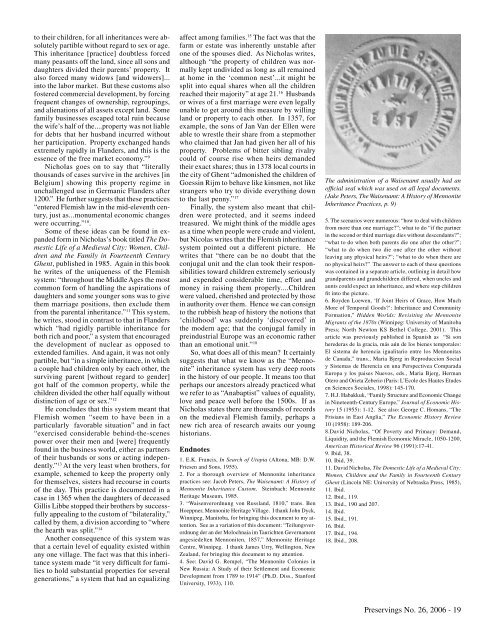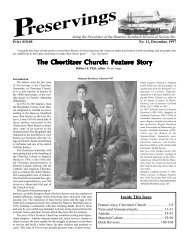Preservings $20 Issue No. 26, 2006 - Home at Plett Foundation
Preservings $20 Issue No. 26, 2006 - Home at Plett Foundation
Preservings $20 Issue No. 26, 2006 - Home at Plett Foundation
Create successful ePaper yourself
Turn your PDF publications into a flip-book with our unique Google optimized e-Paper software.
to their children, for all inheritances were absolutely<br />
partible without regard to sex or age.<br />
This inheritance [practice] doubtless forced<br />
many peasants off the land, since all sons and<br />
daughters divided their parents’ property. It<br />
also forced many widows [and widowers]...<br />
into the labor market. But these customs also<br />
fostered commercial development, by forcing<br />
frequent changes of ownership, regroupings,<br />
and alien<strong>at</strong>ions of all assets except land. Some<br />
family businesses escaped total ruin because<br />
the wife’s half of the....property was not liable<br />
for debts th<strong>at</strong> her husband incurred without<br />
her particip<strong>at</strong>ion. Property exchanged hands<br />
extremely rapidly in Flanders, and this is the<br />
essence of the free market economy.” 9<br />
Nicholas goes on to say th<strong>at</strong> “literally<br />
thousands of cases survive in the archives [in<br />
Belgium] showing this property regime in<br />
unchallenged use in Germanic Flanders after<br />
1200.” He further suggests th<strong>at</strong> these practices<br />
“entered Flemish law in the mid-eleventh century,<br />
just as...monumental economic changes<br />
were occurring.” 10 .<br />
Some of these ideas can be found in expanded<br />
form in Nicholas’s book titled The Domestic<br />
Life of a Medieval City: Women, Children<br />
and the Family in Fourteenth Century<br />
Ghent, published in 1985. Again in this book<br />
he writes of the uniqueness of the Flemish<br />
system: “throughout the Middle Ages the most<br />
common form of handling the aspir<strong>at</strong>ions of<br />
daughters and some younger sons was to give<br />
them marriage positions, then exclude them<br />
from the parental inheritance.” 11 This system,<br />
he writes, stood in contrast to th<strong>at</strong> in Flanders<br />
which “had rigidly partible inheritance for<br />
both rich and poor,” a system th<strong>at</strong> encouraged<br />
the development of nuclear as opposed to<br />
extended families. And again, it was not only<br />
partible, but “in a simple inheritance, in which<br />
a couple had children only by each other, the<br />
surviving parent [without regard to gender]<br />
got half of the common property, while the<br />
children divided the other half equally without<br />
distinction of age or sex.” 12<br />
He concludes th<strong>at</strong> this system meant th<strong>at</strong><br />
Flemish women “seem to have been in a<br />
particularly favorable situ<strong>at</strong>ion” and in fact<br />
“exercised considerable behind-the-scenes<br />
power over their men and [were] frequently<br />
found in the business world, either as partners<br />
of their husbands or sons or acting independently.”<br />
13 At the very least when brothers, for<br />
example, schemed to keep the property only<br />
for themselves, sisters had recourse in courts<br />
of the day. This practice is documented in a<br />
case in 1365 when the daughters of deceased<br />
Gillis Libbe stopped their brothers by successfully<br />
appealing to the custom of “bil<strong>at</strong>erality,”<br />
called by them, a division according to “where<br />
the hearth was split.” 14<br />
Another consequence of this system was<br />
th<strong>at</strong> a certain level of equality existed within<br />
any one village. The fact was th<strong>at</strong> this inheritance<br />
system made “it very difficult for families<br />
to hold substantial properties for several<br />
gener<strong>at</strong>ions,” a system th<strong>at</strong> had an equalizing<br />
affect among families. 15 The fact was th<strong>at</strong> the<br />
farm or est<strong>at</strong>e was inherently unstable after<br />
one of the spouses died. As Nicholas writes,<br />
although “the property of children was normally<br />
kept undivided as long as all remained<br />
<strong>at</strong> home in the ‘common nest’...it might be<br />
split into equal shares when all the children<br />
reached their majority” <strong>at</strong> age 21. 16 Husbands<br />
or wives of a first marriage were even legally<br />
unable to get around this measure by willing<br />
land or property to each other. In 1357, for<br />
example, the sons of Jan Van der Ellen were<br />
able to wrestle their share from a stepmother<br />
who claimed th<strong>at</strong> Jan had given her all of his<br />
property. Problems of bitter sibling rivalry<br />
could of course rise when heirs demanded<br />
their exact shares; thus in 1378 local courts in<br />
the city of Ghent “admonished the children of<br />
Goessin Rijm to behave like kinsmen, not like<br />
strangers who try to divide everything down<br />
to the last penny.” 17<br />
Finally, the system also meant th<strong>at</strong> children<br />
were protected, and it seems indeed<br />
treasured. We might think of the middle ages<br />
as a time when people were crude and violent,<br />
but Nicolas writes th<strong>at</strong> the Flemish inheritance<br />
system pointed out a different picture. He<br />
writes th<strong>at</strong> “there can be no doubt th<strong>at</strong> the<br />
conjugal unit and the clan took their responsibilities<br />
toward children extremely seriously<br />
and expended considerable time, effort and<br />
money in raising them properly....Children<br />
were valued, cherished and protected by those<br />
in authority over them. Hence we can consign<br />
to the rubbish heap of history the notions th<strong>at</strong><br />
‘childhood’ was suddenly ‘discovered’ in<br />
the modern age; th<strong>at</strong> the conjugal family in<br />
preindustrial Europe was an economic r<strong>at</strong>her<br />
than an emotional unit.” 18<br />
So, wh<strong>at</strong> does all of this mean? It certainly<br />
suggests th<strong>at</strong> wh<strong>at</strong> we know as the “Mennonite”<br />
inheritance system has very deep roots<br />
in the history of our people. It means too th<strong>at</strong><br />
perhaps our ancestors already practiced wh<strong>at</strong><br />
we refer to as “Anabaptist” values of equality,<br />
love and peace well before the 1500s. If as<br />
Nicholas st<strong>at</strong>es there are thousands of records<br />
on the medieval Flemish family, perhaps a<br />
new rich area of research awaits our young<br />
historians.<br />
Endnotes<br />
1. E.K. Francis, In Search of Utopia (Altona, MB: D.W.<br />
Friesen and Sons, 1955).<br />
2. For a thorough overview of Mennonite inheritance<br />
practices see: Jacob Peters, The Waisenamt: A History of<br />
Mennonite Inheritance Custom. Steinbach: Mennonite<br />
Heritage Museum, 1985.<br />
3. “Waisenverordnung von Russland, 1810,” trans. Ben<br />
Hoeppner, Mennonite Heritage Village. I thank John Dyck,<br />
Winnipeg, Manitoba, for bringing this document to my <strong>at</strong>tention.<br />
See as a vari<strong>at</strong>ion of this document: “Teilungsverordnung<br />
der an der Molochnaia im Taurichten Gevernament<br />
angesiedelten Mennoniten, 1857,” Mennonite Heritage<br />
Centre, Winnipeg. I thank James Urry, Wellington, New<br />
Zealand, for bringing this document to my <strong>at</strong>tention.<br />
4. See: David G. Rempel, “The Mennonite Colonies in<br />
New Russia: A Study of their Settlement and Economic<br />
Development from 1789 to 1914” (Ph.D. Diss., Stanford<br />
University, 1933), 110.<br />
The administr<strong>at</strong>ion of a Waisenamt usually had an<br />
official seal which was used on all legal documents.<br />
(Jake Peters, The Waisenamt: A History of Mennonite<br />
Inheritance Practices, p. 9)<br />
5. The scenarios were numerous: “how to deal with children<br />
from more than one marriage?”; wh<strong>at</strong> to do “if the partner<br />
in the second or third marriage dies without descendants?”;<br />
“wh<strong>at</strong> to do when both parents die one after the other?”;<br />
“wh<strong>at</strong> to do when two die one after the other without<br />
leaving any physical heirs?”; “wh<strong>at</strong> to do when there are<br />
no physical heirs?” The answer to each of these questions<br />
was contained in a separ<strong>at</strong>e article, outlining in detail how<br />
grandparents and grandchildren differed, when uncles and<br />
aunts could expect an inheritance, and where step children<br />
fit into the picture.<br />
6. Royden Loewen, ‘If Joint Heirs of Grace, How Much<br />
More of Temporal Goods?’: Inheritance and Community<br />
Form<strong>at</strong>ion,” Hidden Worlds: Revisiting the Mennonite<br />
Migrants of the 1870s (Winnipeg: University of Manitoba<br />
Press; <strong>No</strong>rth Newton KS Bethel College, 2001). This<br />
article was previously published in Spanish as “Si son<br />
herederas de la gracia, más aún de los bienes temporales:<br />
El sistema de herencia igualitario entre los Mennonitas<br />
de Canada,” trans., Maria Bjerg in Reproduccion Social<br />
y Sistemas de Herencia en una Perspectivea Comparada<br />
Europa y los paises Nuevos, eds., Maria Bjerg, Herman<br />
Otero and Orieta Zeberio (Paris: L’Ecole des Hautes Etudes<br />
en Sciences Sociales, 1998): 145-170.<br />
7. H.J. Habakkuk, “Family Structure and Economic Change<br />
in Nineteenth-Century Europe,” Journal of Economic History<br />
15 (1955): 1-12. See also: George C. Homans, “The<br />
Frisians in East Anglia,” The Economic History Review<br />
10 (1958): 189-206.<br />
8.David Nicholas, “Of Poverty and Primacy: Demand,<br />
Liquidity, and the Flemish Economic Miracle, 1050-1200,<br />
American Historical Review 96 (1991):17-41.<br />
9. Ibid, 38.<br />
10. Ibid, 39.<br />
11. David Nicholas, The Domestic Life of a Medieval City:<br />
Women, Children and the Family in Fourteenth Century<br />
Ghent (Lincoln NE: University of Nebraska Press, 1985),<br />
11. Ibid.<br />
12. Ibid., 119.<br />
13. Ibid., 190 and 207.<br />
14. Ibid.<br />
15. Ibid., 191.<br />
16. Ibid.<br />
17. Ibid., 194.<br />
18. Ibid., 208.<br />
<strong>Preservings</strong> <strong>No</strong>. <strong>26</strong>, <strong>2006</strong> - 19
















